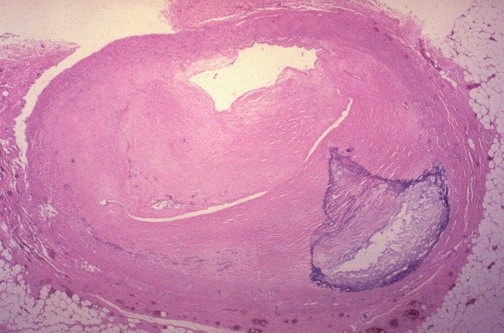 Hardening of the arteries is usually the result of aging, high blood pressure, diabetes, genetics and lifestyle. Our arteries, when young and healthy, are normally flexible, strong and elastic. But as years go by these same artery walls can become thick and stiff thereby restricting blood flow to organs and or surrounding tissues. This hardening of the arteries is called arteriosclerosis.
Hardening of the arteries is usually the result of aging, high blood pressure, diabetes, genetics and lifestyle. Our arteries, when young and healthy, are normally flexible, strong and elastic. But as years go by these same artery walls can become thick and stiff thereby restricting blood flow to organs and or surrounding tissues. This hardening of the arteries is called arteriosclerosis.
Note the purple area in the picture to the left. The purple area is a portion of calcified, hardened artery.
Arteriosclerosis and atherosclerosis are terms that are often used interchangeably. Hardening of the arteries, arteriosclerosis, is not the same condition as atherosclerosis; however, atherosclerosis is a form of arteriosclerosis. In fact …
Millions of people who now have atherosclerosis, will eventually have both conditions because atherosclerotic plaque often hardens due to calcification resulting in the thick, stiff and narrowed arteries characterized in arteriosclerosis. Yes, I know that is somewhat confusing however it will hopefully become more clear as we proceed.
Arteriosclerosis or Atherosclerosis , What’s the Difference?
Arteriosclerosis differs from atherosclerosis, even though the terms are often used interchangeably. For example arteriosclerosis is the actual hardening of the arteries, most often due to age, to much pressure (high blood pressure) and calcification of the arteries. It’s this calcification that is responsible for the stiffening and thickening of the artery walls that can compromise blood flow. The arteries become rigid, lose their elasticity and grow thick or swell.
Mönckeberg’s arteriosclerosis, which doesn’t involve atherosclerosis, is a hardening of the arteries due to calcification. It is most commonly found in the Ulnar and Radial arteries and in people over 50 years of age who also have diabetes. Calcium hardens the medium sized vessels thereby causing them to lose their elasticity. Unless it is severe it usually doesn’t present with symptoms. On the other hand …
Atherosclerosis, the most common form of arteriosclerosis, is characterized by a build up of arterial plaque that may become hardened by calcium. Artery plaque usually takes time to accumulate as well and is normally made up of oxidized LDL cholesterol, fibrin, calcium and various other forms of debris. I know this may be confusing so …
To Understand Artery Plaque and Calcified Arteries
 In order to better understand plaque look at an artery as a donut. You have the donut and a hole. The donut cake is the artery itself and the hole is the channel through which blood flows.
In order to better understand plaque look at an artery as a donut. You have the donut and a hole. The donut cake is the artery itself and the hole is the channel through which blood flows.
Atherosclerotic plaque, which is a pasty substance made up of oxidized LDL and VLDL cholesterol, fibrin, calcium and other debris can fill the hole, bury itself within the artery wall (the cake) or both. However …
This scenario can be somewhat different than that of arteriosclerosis or hardening of the arteries because atherosclerotic plaque does not have to actually harden. It can remain a pasty goo. In fact the most deadly form of plaque is known as “vulnerable plaque.” This is the plaque that does not harden due to calcification and can easily rupture leading to immediate complications such as heart attack and stroke. In fact vulnerable plaque is responsible for 80% of heart attacks.
Atherosclerosis is the accumulation of artery plaque within the arterial channel or walls whereas arteriosclerosis is the actual stiffening, thickening and loss of flexibility of the artery wall itself due to age and calcification. So …
Can you have hardening of the arteries, arteriosclerosis, without having atherosclerosis? Yes you can, Mönckeberg’s arteriosclerosis is a prime example. The artery simply becomes calcified.
Does Atherosclerosis lead to arteriosclerosis, hardening of the arteries? Yes it does. Long term atherosclerotic plaques calcify causing the artery to lose its flexibility and stiffen and viola! You have arteriosclerosis. And that is exactly why people with atherosclerosis tend to have both conditions.
Coronary Arteriosclerosis
Hardening of the coronary arteries
What Does a Calcified Peripheral Artery Look Like?
Arteriosclerosis pictures
Cerebral Arteriosclerosis
Hardening of the arteries of the brain
Cerebral Arteriosclerosis is hardening of the arteries within the brain and can cause serious health problems. When the walls of an artery located within the brain become stiff and thick the thickening can impede blood flow and if the blood flow is blocked enough by either the thickening of the artery wall itself or a blood clot that blocks the narrowed channel it can result in TIA’s (Transient Ischemic Attacks) or a full blown ischemic stroke.
If the thickening and hardening of the arteries is less than even the arterial walls could develop bulges, known as aneurysms, and should the aneurysm rupture, the bleeding in the brain can cause a hemorrhagic stroke. Both types of stroke can be fatal.
My Summary Thoughts


